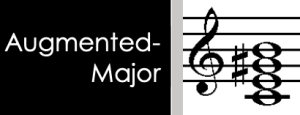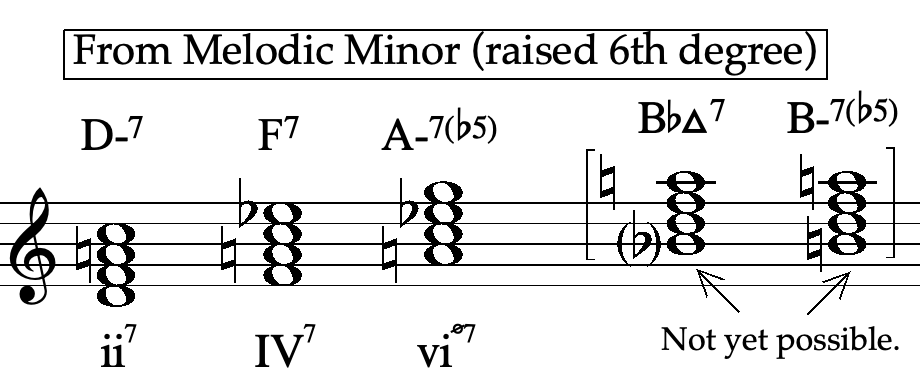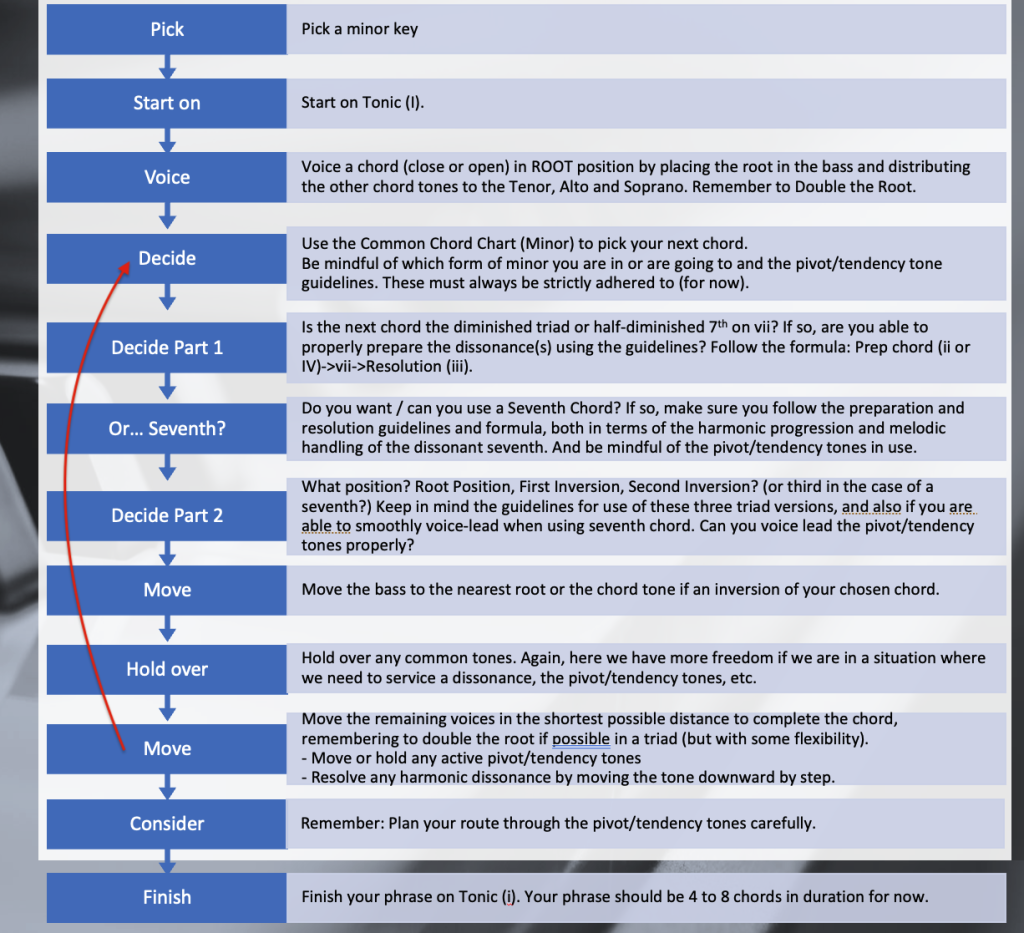Western Harmonic Practice I: Diatonic Tonality
12 The Minor Mode II: Voice Leading with Seventh Chords and Inversions
Key Takeaways
This chapter expands on the possibilities offered by triad inversions and seventh chords in the minor mode while emphasizing the importance of adhering to the established voice leading guidelines. We will learn about new seventh chord qualities in the minor mode and discover how to navigate their resolutions. And gain further insights into the handling of harmonic dissonance in conjunction with the minor mode’s pivot/tendency tones.
-
- Inversions Enhance Voice Leading in Minor: The use of inversions in the minor mode allows for richer voice leading and aids in the nuanced management of pivot/tendency tones. Adhering to established voice leading guidelines remains paramount, however.
- Seventh Chords in Minor Introduce Novel Qualities: The minor mode brings forth many options for seventh chords, including two new seventh chord qualities, namely theaugmented-major seventh chordand the fully diminished seventh chord. Both chords contribute distinct tonal colors.
- Seventh Chord Resolutions Are Crucial: Proper understanding of the characteristics and resolutions of seventh chords is indispensable for maintaining the integrity of harmonic progressions and stylistic balance within the minor mode.
- Harmonic Dissonance Challenges: Some seventh chords present challenges in resolving harmonic dissonance while still adhering to pivot/tendency tone guidelines. Not all of the seventh chords which are possible are currently usable under these guidelines.
- The “Fully” Diminished Seventh Chord: This chord, arising from the harmonic minor, serves as a powerful tool. It can be strategically employed for its distinct sound, effective tension, and resolution.
- Careful Consideration of Voice Leading: The incorporation of seventh chords necessitates careful preparation and resolution of harmonic dissonance, especially in conjunction with pivot/tendency tones in the minor mode.
Triad Inversions in Minor
Seventh Chord Qualities and Labeling in Minor
As in the major mode, each scale degree in minor will, when a seventh chord is built by stacking up four notes in thirds with the scale degree as the root, produce different qualities of seventh chord. In minor, however, we get the addition of two new seventh chord qualities: The augmented-major seventh, and the diminished seventh (sometimes referred to as the “fully” diminished to distinguish from the “half” diminished seventh we already know.).
In context, when mapped onto a specific minor scale (C minor), we have the following:
Figure 1. Seventh chords in the minor mode (C minor).
As with triads, we label our seventh chords with both a Roman numeral analysis designation and a lead-sheet chord symbol. Since we have the two forms of the minor mode, ascending (harmonic and melodic) and descending (natural), we have a number of scale degrees that have more than one possible seventh chord variety depending on which form of the mode is in operation. The different chord variations are shown below.
Figure 2. The seventh chords specific to Harmonic Minor with the raised seventh scale degree (shown in C minor).
Figure 3. The seventh chords specific to Melodic Minor with the raised sixth scale degree (shown in C minor).
New Seventh Chords in Minor
In the minor mode, we encounter two new varieties of seventh chord which do not occur in major: The augmented-major seventh and the diminished seventh.
The Augmented-Major Seventh
 Built on the mediant, scale degree
Built on the mediant, scale degree ![]() in the ascending form of the minor mode containing the artificially raised seventh scale degree (
in the ascending form of the minor mode containing the artificially raised seventh scale degree (![]() ), the augmented-major seventh chord is an augmented triad with a major seventh chord tone in relationship to the root. This chord is also known as a “major seven sharp five”, similar to how we may refer to the half-diminished chord as a “minor seven flat five”. The fifth chord tone is altered, raised by a half step, differentiating from a plain major-major seventh chord. In lead sheet notation it is best to use the major triad quality symbol followed by a superscript 5. It has a strong and stringent sound and can be very powerful and effective at a climatic moment in a phrase as the chord possesses great color and tension. It should be used sparingly in diatonic tonal music owing to this powerful character.
), the augmented-major seventh chord is an augmented triad with a major seventh chord tone in relationship to the root. This chord is also known as a “major seven sharp five”, similar to how we may refer to the half-diminished chord as a “minor seven flat five”. The fifth chord tone is altered, raised by a half step, differentiating from a plain major-major seventh chord. In lead sheet notation it is best to use the major triad quality symbol followed by a superscript 5. It has a strong and stringent sound and can be very powerful and effective at a climatic moment in a phrase as the chord possesses great color and tension. It should be used sparingly in diatonic tonal music owing to this powerful character.
The Diminished Seventh Chord (“Fully Diminished”)

Built on the artificial leading-tone scale degree in ascending minor, scale degree (![]() ), the diminished seventh chord is a diminished triad with a diminished seventh chord tone in relationship to the root. It is also sometimes called a “fully diminished” chord so as to distinguish itself from “half diminished” chord which is similar. This chord is unique and effective in a number of ways and, in minor is further specialized in that we are using specifically Harmonic Minor with both the raised seventh scale degree AND the natural sixth scale degree
), the diminished seventh chord is a diminished triad with a diminished seventh chord tone in relationship to the root. It is also sometimes called a “fully diminished” chord so as to distinguish itself from “half diminished” chord which is similar. This chord is unique and effective in a number of ways and, in minor is further specialized in that we are using specifically Harmonic Minor with both the raised seventh scale degree AND the natural sixth scale degree ![]() simultaneously as active chord tones. The chord is extremely effective in moments of tension and climax with a very hazy and diffuse sound, ungrounded by any perfect fifth interval in its construction. Later we will learn that this chord has a dominant function as is in fact an incomplete dominant ninth chord.
simultaneously as active chord tones. The chord is extremely effective in moments of tension and climax with a very hazy and diffuse sound, ungrounded by any perfect fifth interval in its construction. Later we will learn that this chord has a dominant function as is in fact an incomplete dominant ninth chord.
Additional Voice Leading Considerations
With the addition of seventh chords in the minor mode, a few additional considerations must be made with regard to proper voice leading in SATB style as we must both consider the preparation and resolution of harmonic dissonance (7ths and diminished 5ths where they occur), and the proper handling of the pivot/tendency tones in the minor mode. These two considerations lead to a several specific conditions:
First, at this time we have a few seventh chords that will be unusable and were already shown above:
Figure 4. The three currently unusable seventh chords in the minor mode (shown in C minor)
Each of these seventh chords contains an as yet unsolvable problem under our current, strict, guidelines when both trying to resolve the harmonic dissonance properly, and satisfy the voice leading conditions of the pivot/tendency tones.
Figure 5. The problem of handing the dissonance and pivot/tendency tones in the three unusable seventh chords (shown in C minor)
Each of these chords presents a problem in that we can not resolve the harmonic dissonance of the seventh while, at the same time, satisfy the pivot/tendency tone guidelines as the seventh in all three cases is one of the pivot/tendency tones out of the Ascending form or the minor mode: The seventh must voice-lead downward to resolve but the pivot/tendency tone must go up (or hold over). At this time, we will consider these chords as not possible under the current conditions and save these for when we obtain a greater level of understanding and mastery of the subject and are then allowed much greater freedom and flexibility
There is, however, a condition which does exist when using the fully diminished seventh chord, built on the raised seventh scale degree in the Ascending form of minor where we have both the raised seventh and natural sixth scale degrees of the mode voiced in the chord at the same time. This is, in fact, perfectly acceptable and even desirable as this chord comes directly out of Harmonic minor which, as we know, contains the natural sixth and raised seventh scale degrees. In this case, we handle these two tones exactly as expected: The raised seventh will move upward to the tonic (scale degree 1), satisfying the pivot/tendency tone guideline #1, and the natural scale degree 6 will fall to scale degree 5, satisfying pivot/tendency tone guideline #3.
Figure 6. The two possible resolutions of the diminished (“fully”) seventh chord (shown in C minor)
Soon, we will be able to resolve this chord directly to the tonic (i) minor triad but, for now, these are the only two possible resolutions under the current guidelines.
Chord Connection Guidelines in Minor: V2
Now that we have added seventh chords to the mix in the minor mode , we may now further adjust our tonal harmony part-writing flowchart for the minor mode:
Common Tone Chord Chart: Triads (Minor Mode)
| Chord | Has common tones with... | |||||||
|---|---|---|---|---|---|---|---|---|
| i | III | III+( |
iv | IV ( |
v | V ( |
VI | vi ( |
| ii | v | V ( |
||||||
| ii ( |
IV ( |
V ( |
vii ( |
|||||
| III | v | VI | VII | *i | ||||
| III+ ( |
V ( |
vii ( |
i | VI | ||||
| iv | VI | *VII | i | *ii | ||||
| IV ( |
vii ( |
ii ( |
||||||
| v | VII | *i | III | |||||
| V ( |
i | III+ ( |
||||||
| VI | i | ii | *III | III+ ( |
iv | |||
| vi ( |
ii ( |
|||||||
| VII | III | iv | v | |||||
| vii ( |
III+ ( |
iv | *IV ( |
V ( |
||||
A chart of chords (triads) in the tonal minor mode which have at least one tone in common and are permissible with the voice leading guidelines of the pivot/tendency tones in the minor mode. Chords show in bold are from the Ascending form of minor (harmonic/melodic) along with the active scale degree shown for further clarity. The asterisk (*) shows either a connection in the Natural (descending) form of minor where the downward motion of the natural pivot/tendency tone is avoided or a move (italicized) that does not properly prepare or resolve the diminished fifth dissonance. Both are to be avoided until we relax the guidelines and have a freer treatment of both the Natural form of minor and the diminished fifth dissonance.
The table is the same as before and should be a good, general guide. However, do note that the addition of seventh chords may, as we have learned, prevent certain moves from happening. Everything at this point must be context driven with the following questions being asked from moment to moment:
- Can I prepare or resolve any dissonance(s)?
- Can I satisfy the voice-leading guidelines for any active pivot/tendency tones?
- Am I moving from one chord to another that has at least one common tone, even if I am best to not hold over that tone in the same voice because of other, more important voice-leading considerations?
EXAMPLES: Triad Inversions and Seventh Chords in the Minor Mode
If the score above is not displaying properly you may CLICK HERE to open it in a new window.
RWU EXERCISES
Mixed Triads and Seventh Chords in Short Phrases
Using the template below, do the following:
- Compose at least three harmonic progressions of your choice, at least 8 to 14 chords in length, one may be in A minor, and the other two any minor key of your choosing.
- Follow the guidelines set above.
- You must have at least two seventh chords in each phrase. Try, across your three attempts, for a good variety of seventh chords chosen out of each form of the minor mode (Ascending or Natural).
- Use inversions wherever you wish according to the already established guidelines for voice leading. Strive for a decent mixture of root position chords (triads and sevenths) along with your inversions.
- You may connect seventh chords to one another provided that the voice-leading guidelines are not violated.
(you must be logged into your Noteflight account to open the activity templates above)
Schoenberg Theory of Harmony Examples
Further Reading
- Schoenberg, Arnold: Theory of Harmony
- Schoenberg, Arnold: Structural Functions of Harmony
a major seventh chord with a raised fifth scale degree. Often referred to as a "major seven sharp five".
a seventh chord that is built from a diminished triad with a diminished seventh above the root.
scale degree 3 in the diatonic major and minor modes, located a third above the tonic, and a fifth above the submediant.







